User:Arsonal/Indonesia sandbox
General
[edit]- JKT48: [1], [2], [3]
- http://lcweb2.loc.gov/frd/cs/indonesia/
- http://www.seasite.niu.edu/indonesian/Reformasi/Chronicle/default.htm
- http://www.globalintegrity.org/reports/2006/indonesia/timeline.cfm
- http://bos.fkip.uns.ac.id/pub/ono/pendidikan/sejarah/
- Popular culture in Indonesia
- [4] Completely cited photo of DPR building occupation by university students
- Cribb, Robert (2000). Historical Atlas of Indonesia. Richmond, London: Curzon. ISBN 978-0-7007-0985-4.
{{cite book}}: CS1 maint: postscript (link) - Leo Suryadinata: 廖建裕
Chinese Indonesian
[edit]- User:Arsonal/Indonesia sandbox/Chinese Indonesian
- Ong, Aihwa (2005), "Chinese Diaspora Politics and Its Fallout in a Cyber Age", in Ember, Melvin; Ember, Carol R.; Skoggard, Ian (eds.), Encyclopedia of Diasporas: Immigrant and Refugee Cultures Around the World, New York, N.Y.: Springer Science+Business Media, pp. 392–403, ISBN 978-0-387-29904-4.
{{citation}}: Unknown parameter|lastauthoramp=ignored (|name-list-style=suggested) (help) - Williams, Lea E. (1960), Overseas Chinese Nationalism: The Genesis of the Pan-Chinese Movement in Indonesia, 1900–1916, Glencoe, I.L.: Free Press.
- Wilmott, David E. (1961), The National Status of the Chinese in Indonesia, 1900–1958, Ithaca, N.Y.: Cornell University Press.
- Yang, Heriyanto (2005), "The History and Legal Position of Confucianism in Post-Independence Indonesia" (PDF), Marburg Journal of Religion, 10 (1), ISSN 1612-2941, retrieved 26 January 2010.
{{citation}}: Unknown parameter|month=ignored (help)
Recent construction of megachurches are seen as an assertion of faith among wealthy Christian leaders. Unlike in other parts of Asia, megachurches in Indonesia largely refrain from proselytizing to avoid unwanted conflict. Megachurches in Jakarta were built either in commercial districts or in Christian parts of the city with financial support from prominent Chinese Indonesian businesspeople.[3]
Sin Po later changed its name to Warta Bakti.[4] Harian Indonesia. It later merged with Sin Chew Jit Poh.[5]
Radio Cakrawala in Jakarta also added music and news programming in Mandarin at the same time. The station had previously played Mandarin pop songs that were rerecorded with Indonesian lyrics.[6]
- ^ Savitri, Alpha (13 June 2003). "Cheng Hoo: A mosque with some Chinese flair". The Jakarta Post. Retrieved 26 January 2010.
- ^ Chua, Edmond (18 September 2008). "Largest Chinese Church Overseas to Open in Jakarta". The Christian Post. Retrieved 24 February 2010.
- ^ Wright, Tom (4 September 2008). "Improbable Houses of Worship". The Wall Street Journal. Retrieved 14 May 2010.
- ^ Hoon, Chang-Yau (2006), "'A Hundred Flowers Bloom': The Re-Emergence of the Chinese Press in Post-Suharto Indonesia", in Sun, Wanning (ed.), Media and the Chinese Diaspora: Community, Communications, and Commerce, Media, Culture, and Social Change in Asia, London: Routledge, ISBN 978-0-415-35204-8.
- ^ Winarti, Agnes (15 May 2008). "Chinese papers attracting younger readers". The Jakarta Post. Retrieved 26 January 2010.
- ^ Montlake, Simon (23 July 2008). "Ethnic Chinese find a voice in Indonesia". The Christian Science Monitor. Retrieved 29 January 2009.
Official story, left Bogor at 8:30 pm, 11 March (see OCLC 212626347)
- Typist Ali Ebram
- Amirmachmud - biography OCLC 18379677
- Basuki Rahmat
- Mohammad Jusuf - biography OCLC 85016639
Alternate story, left Bogor at 1 am, 12 March (see OCLC 225420443)
- Told by Cakrabirawa soldier Sukardjo Wilardjito/Soekardjo Wilardjito
- Possibly Maraden Panggabean included in holding Sukarno at gunpoint
- Supported by Cakrabirawa soldiers Kaswadi and Rian Ismail
See also PNRI archive of Detik.com article.
Mendur brothers
[edit]

Alexius Impurung Mendur (1907 – 1984) was an Indonesian photographer and one of the founders of the Indonesia Press Photo Service (IPPHOS).
Frans Soemarto Mendur (1913 – 1971) was an Indonesian photographer and one of the founders of the Indonesia Press Photo Service (IPPHOS).
- "Karya Dua Bersaudara Mengabadikan Sejarah" (in Indonesian). Sinar Harapan. 16 June 2005. Archived from the original on 30 April 2009. Retrieved 22 June 2009.
- Ahamada, Yuli (5 December 2008). "Foto Legendaris Itu Dijepret di Mojokerto" (in Indonesian). Surya. Archived from the original on 5 March 2013. Retrieved 22 June 2009.
- Mariani, Eva (22 June 2005). "Oktagon to hold photofest on RI's development". The Jakarta Post. Retrieved 22 June 2009.
- [5]
- [6]
- [7]
- [8]
- [9]
- [10]
- [11]
- [12]
- IPPHOS formally established October 2, 1946, along with Justus & Frans Umbas, Alex Mamusing, and Oscar Ganda. [13][14]
- Setiawan, Iwan (14 June 2009). "Riri Riza: Film as a cultural product". The Jakarta Post. Retrieved 14 June 2009.
- Bremner, Brian; Shameen, Assif (11 July 2005). "Indonesia's Crisis Manager". BusinessWeek. Retrieved 23 June 2009.
- Bremner, Brian; Shameen, Assif (4 July 2005). "Yudhoyono's "Triple-Track Strategy"". BusinessWeek. Retrieved 23 June 2009.
- Dwiyanto, Djoko (2009). Kraton Yogyakarta: Sejarah, Nasionalisme, & Teladan Perjuangan (in Indonesian). Yogyakarta: Paradigma Indonesia. ISBN 978-979-17834-0-8.

